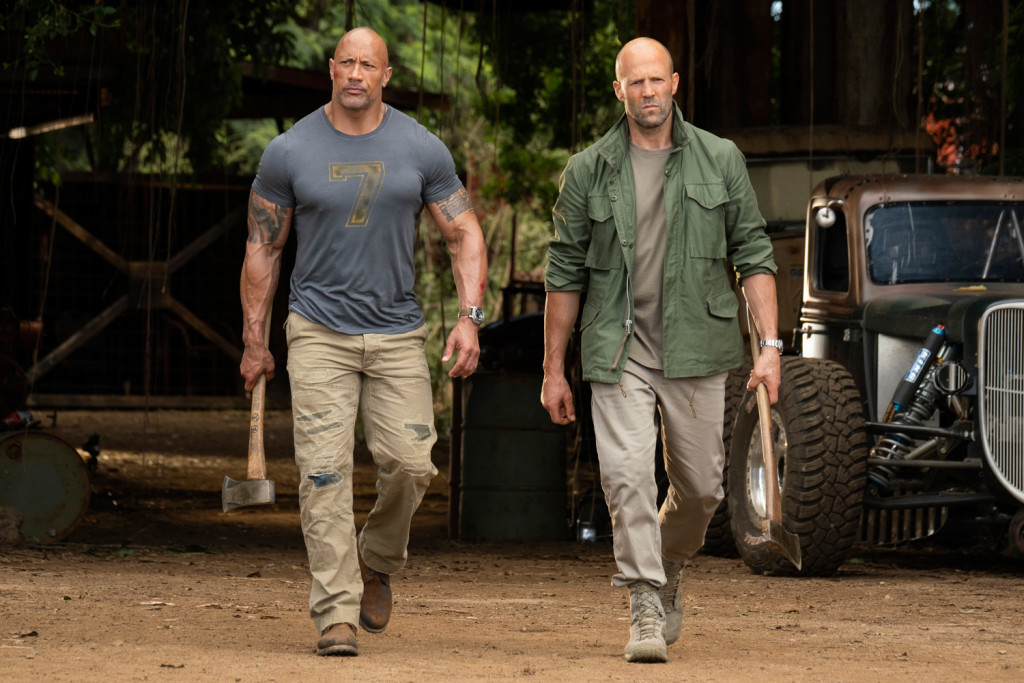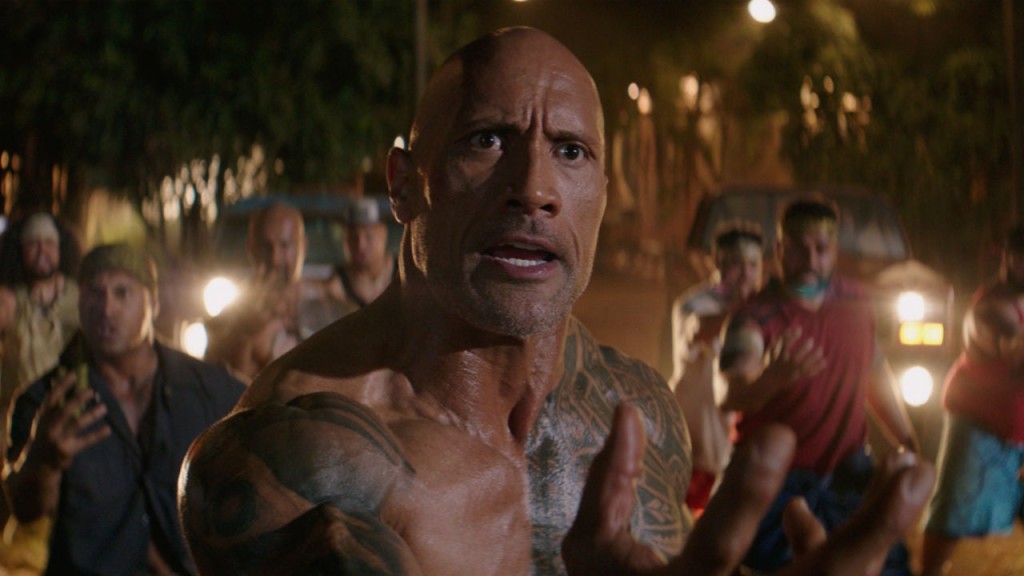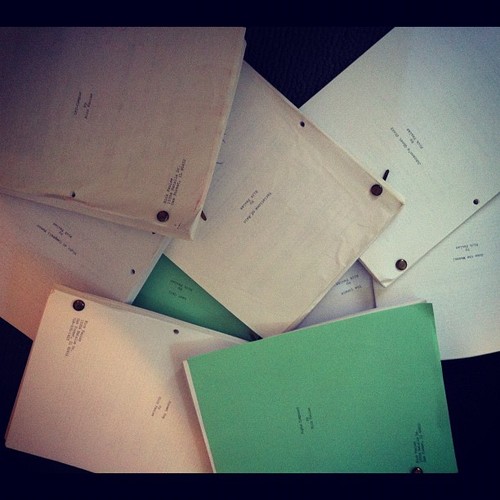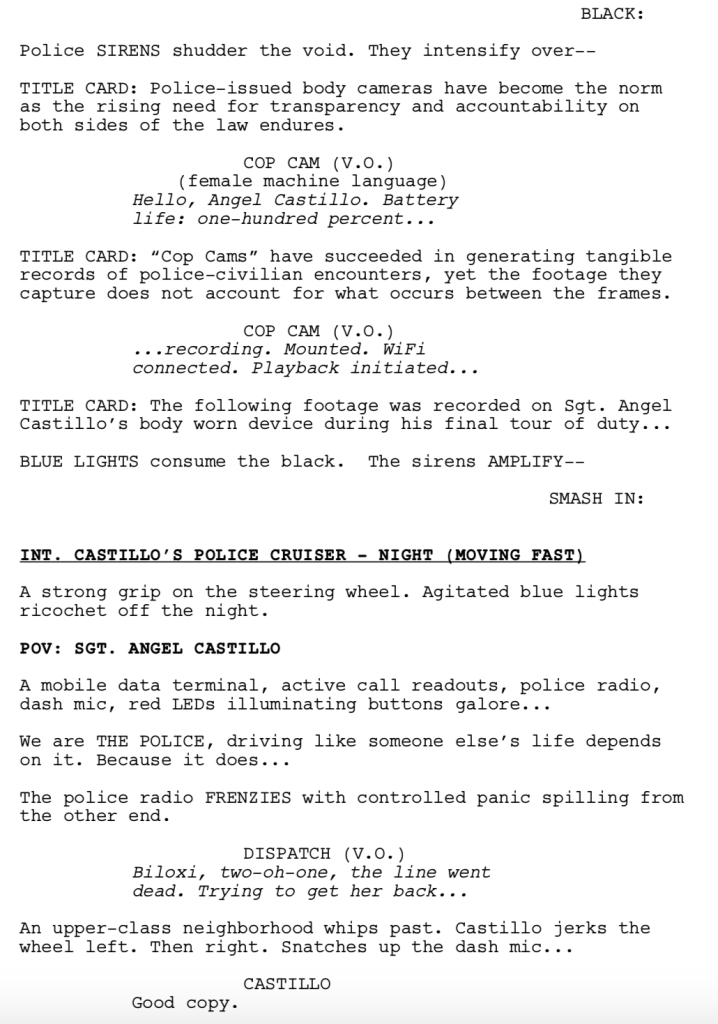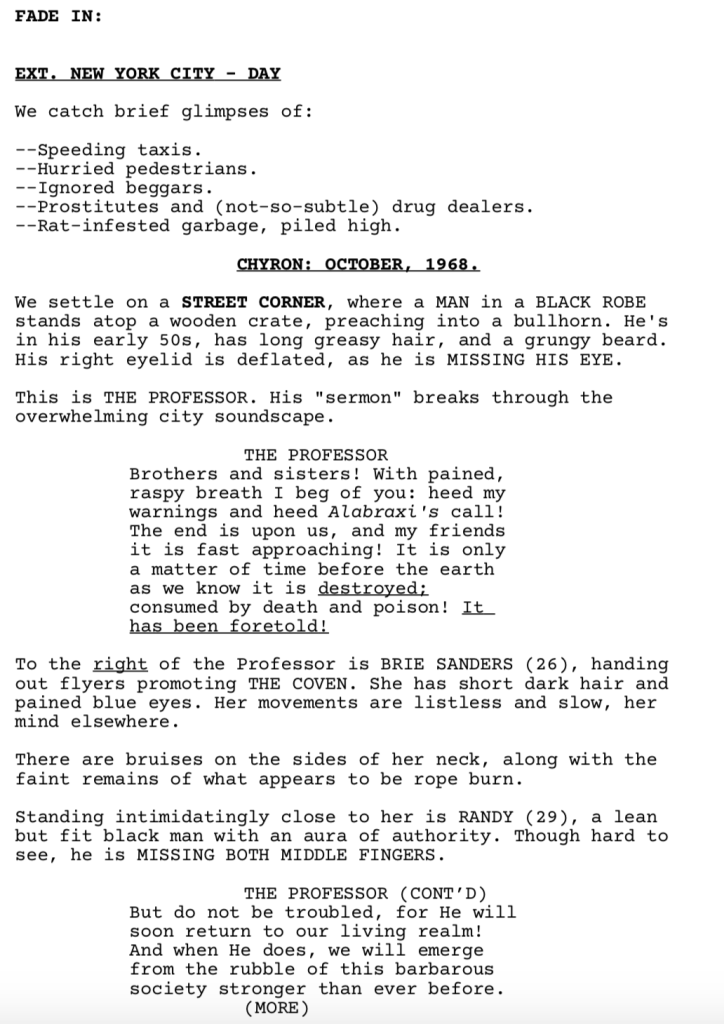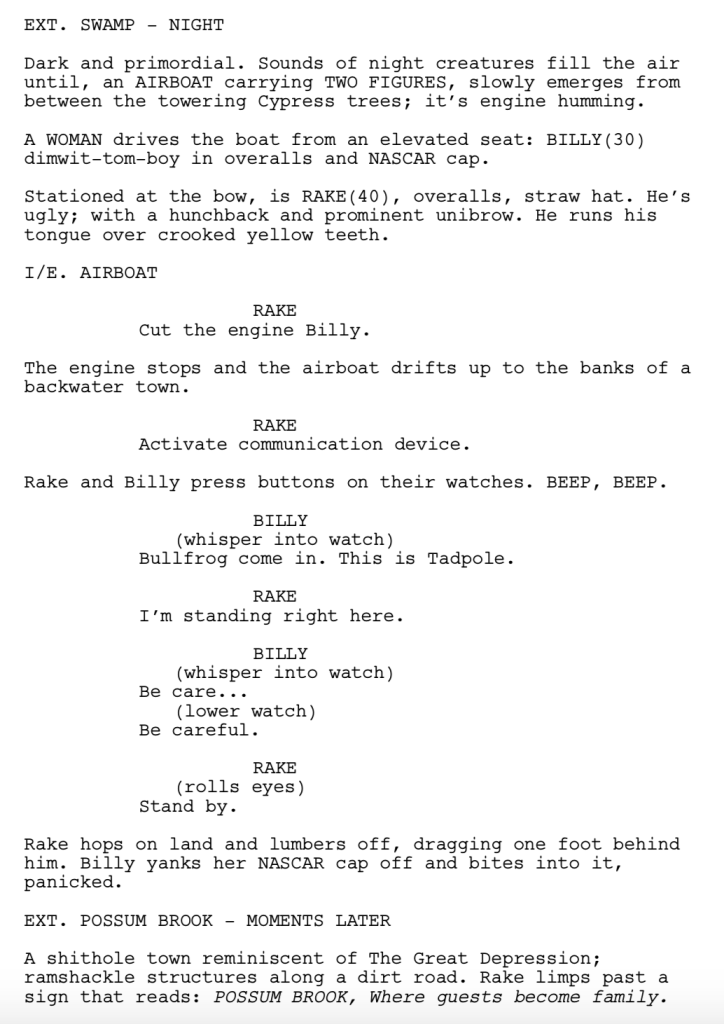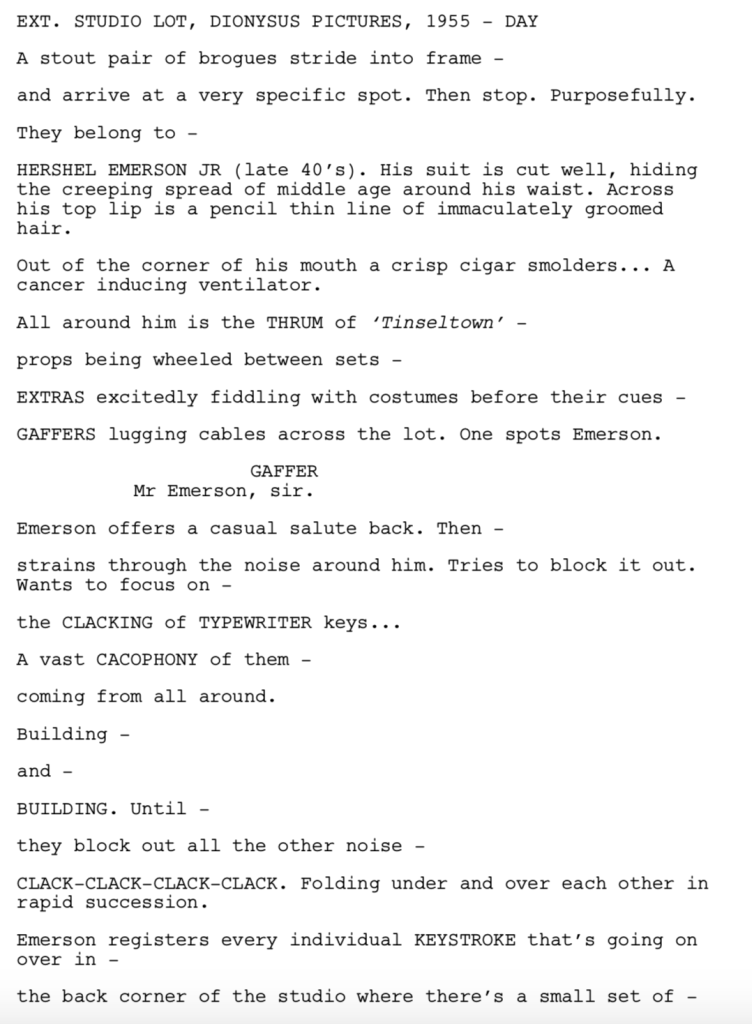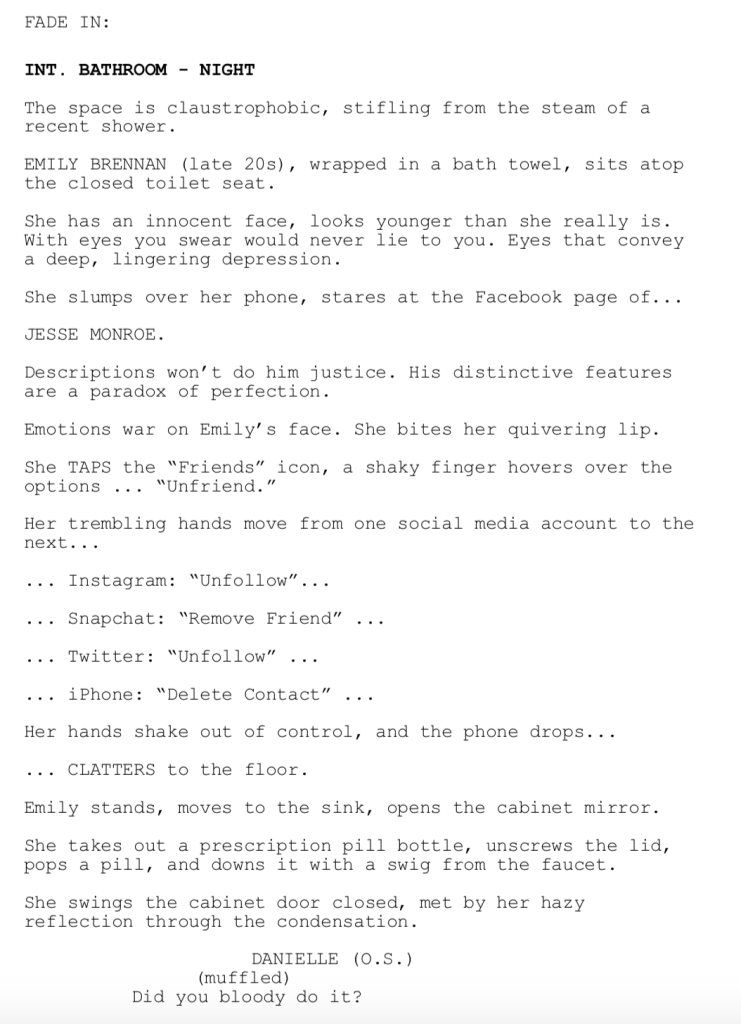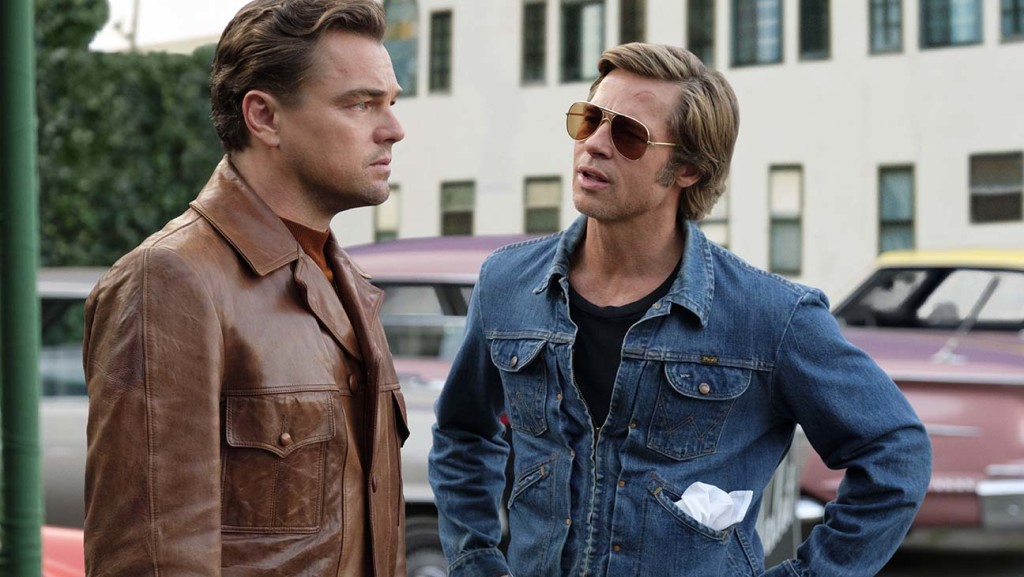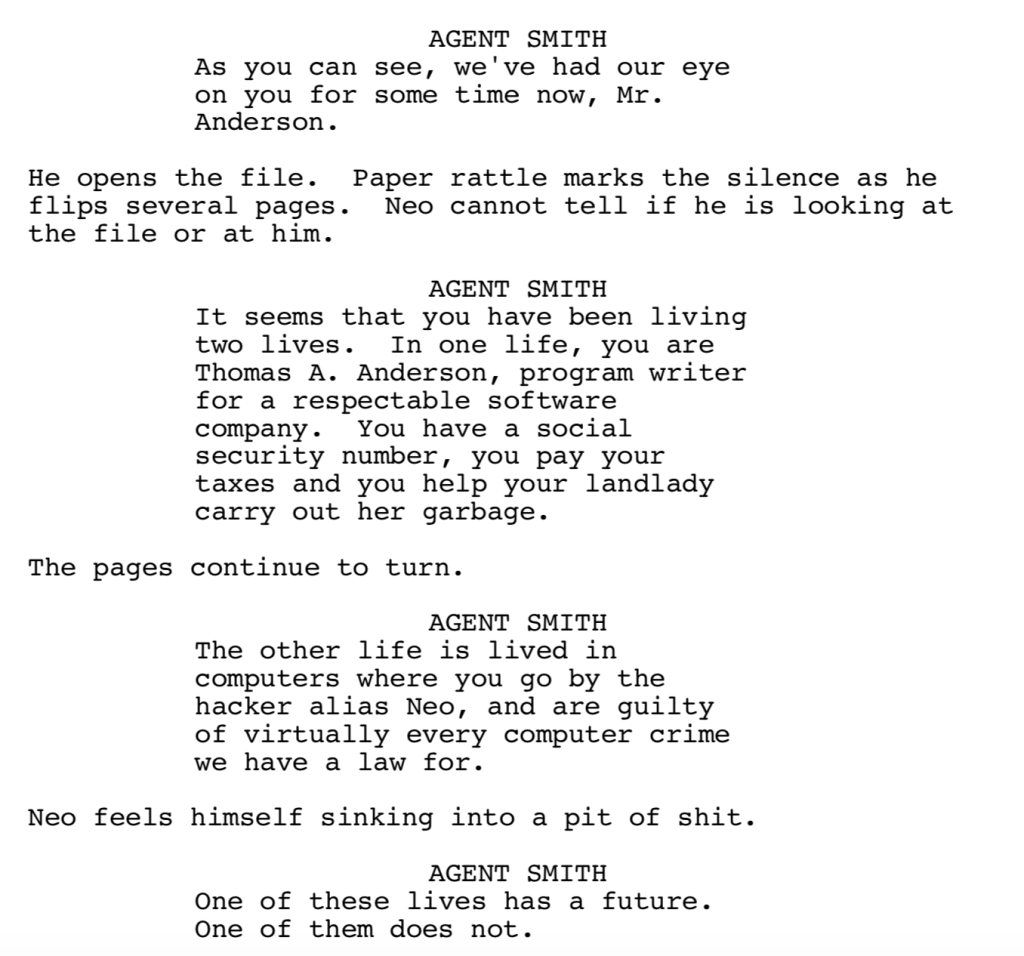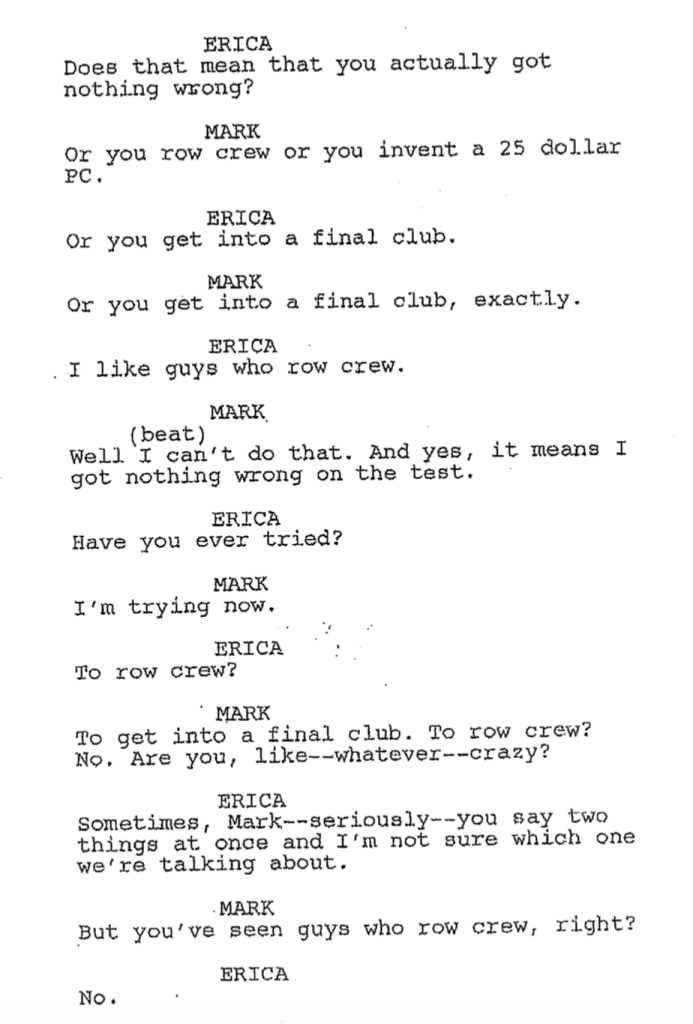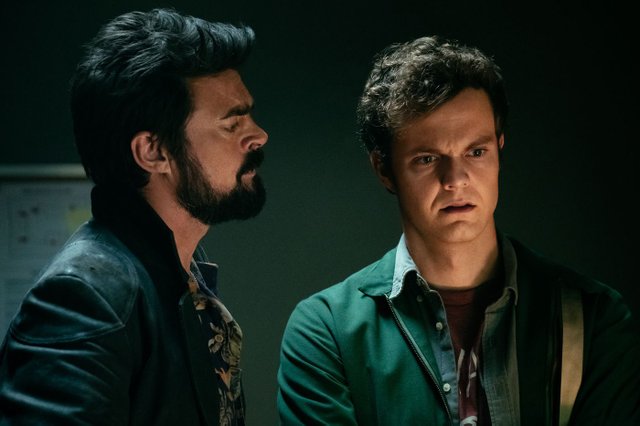Genre: Action
Premise: (from IMDB) Lawman Luke Hobbs and outcast Deckard Shaw form an unlikely alliance when a cyber-genetically enhanced villain threatens the future of humanity.
About: Hobbs and Shaw contains a ton of drama, and that’s just in the production of the film! Tempers flared when Fast and Furious OG Vin Diesel learned that they were going to make Fast and Furious movies without him. Tyrese Gibson, who plays Roman on the series, even took to his Instagram to call out the selfish Rock for prioritizing the spinoff over the next Fast and Furious sequel. Needless to say, there were a lot of people wanting a lot of different results from the Hobbs and Shaw box office this weekend. The film is said to be a success with its 60 million dollar domestic opening. However, it should be noted that the last Fast and Furious movie made 100 million dollars its opening weekend. So is this really a success? I don’t know. Long-standing franchise scribe Chris Morgan is back yet again to write the spin-off.
Writer: Chris Morgan
Details: 2 hours and 17 minutes
Before I get to Hobbs and Shaw, can I just say something?
F&%$ Christopher Nolan.
No, seriously. F&%$ Christopher Nolan.
There isn’t a director on this planet more full of himself than this schmuck. Talk about a clueless dolt who gets high off the smell of his own s$&#.
If you don’t know what I’m talking about, Nolan put up a teaser trailer for his new movie, Tenet, this weekend in front of Hobbs and Shaw. Nolan, he who still spends his off-time marching for 35mm film rights and denouncing streaming services, couldn’t be bothered to put his trailer up on the internet first. Why? Because he’s Christopher Nolan. A Christopher Nolan film, according to Christopher Nolan, is such a monumental life-changing event, that its trailer cannot, will not, be shown online first. It will only be shown in theaters, the way they used to do it 30 years ago.
None of this would matter if this self-appointed genius’s teaser trailer was actually, you know, good. But let me break this trailer down for you and you can decide. We open on a shot of a bullet hole in glass. Behind the glass is a man who’s out of focus. We then get some weird title card that proclaims, “It’s time for a new kind of protagonist.” We cut back to see the camera moving across the glass and we see… ANOTHER bullet hole. Ooooooooh. Man, the anticipation is killing me. Two bullet holes in glass? A new kind of protagonist with no explanation of what that means!? Wooooowwwwww, bro.
But it gets better. The out of focus man then comes INTO focus and INSPECTS the bullet hole. Yeah. That’s a new kind of protagonist all right. Guy knows how to inspect a bullet hole! I’ve never seen a protagonist like that before. But we’re not done yet. We then cut to a quick stock footage shot of a riot. HOLY BALLS! Riot stock footage! You’re right Christopher Nolan! This teaser trailer could only be appreciated in theaters. Youtube never would’ve done this stock footage justice. Annnnnnnnnd…. that’s the trailer.
THAT’S IT! That’s all we get.
This is the kind of trailer that signifies a director who’s out of touch. He thinks he’s still Six Weeks After Dark Knight Came Out Christopher Nolan. Brother? You put out a sci-fi movie that ended in a bookshelf. You don’t get to cut together 12 seconds of footage that you shot in your basement, throw in a couple of title cards, and people go crazy anymore. You need to give us something of actual substance. I hope this trailer wins top prize for worst trailer of 2019. Because that’s how unnecessary it was. Call us when you’ve actually shot some of your movie, dude.
Hobbs and Shaw.
Hobbs and Shaw is the anti-Christopher Nolan film. There are no spinning dreidels. They are not purporting to do anything other than make people laugh and have a good time. This movie doesn’t carry a single serious bone in its body. But that directive comes with its own set of challenges. Here’s a breakdown of the plot if you didn’t see it.
Hobbs (The Rock) – who I think is a CIA agent? – is called onto a case where a British agent, Hattie, was forced to inject herself with a secret black-plague level virus to escape a bad guy. But now everyone, including the British government, wants to kill her because this virus is so dangerous. It will be up to Hobbs, who is the best tracker in the world (I’m just learning that this movie) to find her and bring her back to safety.
By the way, can someone tell me how it is that when movie people get injected with deadly viruses that could wipe out the entire planet they don’t die themselves? That’s kind of an important detail don’t you think? I mean, you’re trying to convince us that the world is in danger, yet the only person we see that actually has the virus in them is running around and beating the crap out of people without so much as having to re-apply eyeliner.
Anyway.
When Hobbs gets to London to start looking for this girl, he’s told he has to team up with, oh yeah, you guessed it, Shaw (Jason Statham). They actually find the girl pretty quick, but there’s a twist. Hattie is Shaw’s sister! And she’s clearly got the hots for Hobbs. It’s Shaw’s worst nightmare!
The three of them are attacked by self-proclaimed “bad guy,” Brixton (Idris Elba), who could do so many villainous things if he could just get his hands on that virus! But after a couple of car chases around London and, I think, Russia, the three of them escape the pesky Brit, who I forgot to tell you has been fused together with an artificially intelligent machine so that he has super strength. I swear I didn’t make that up.
Hobbs realizes that the only place they’ve got a shot at defeating Brixton is in his home state of Hawaii. Only problem is he hasn’t been back there in 30 years and everyone in Hawaii hates him. Lucky for him, his family and friends are big fans of Braveheart. Cause they prepare for a showdown with Brixton and his army (I guess Brixton has an army now) that is a beat for beat remake of that film’s famous battle. Who’s going to win? How dare you ask me such a question. Pay 15 bucks and find out yourself!
Before I break down Hobbs and Shaw, let me tell you what I require from a film like this. First, I want the chemistry between the leads to be great. Honestly, if you pull that off, nothing else matters. Two, I want to see some things I’ve never seen before. The reason I’m paying 20 bucks (with parking) to come see your movie in the theater as opposed to waiting for it to come out on digital? Is that this is a mega-budget movie that can show me things non mega-budget movies can’t. And finally, I require a good plot. It doesn’t have to be great. These movies never have great plots. But it needs to feel like they’ve put some effort into it. Again, I’m paying more money and giving more of my time, which means stringing together a bunch disassociated content isn’t going to be enough. It’s got to be coherent and keep me engaged.
So how did Hobbs and Shaw do in those three categories?
CHEMISTRY: C+
The chemistry between The Rock and Jason Statham is adequate but never good. The script isn’t doing them any favors. Nothing is written here that would imply these two hate each other. The only reason they hate each other is because it’s a movie. That’s one of the biggest sins you can commit as a screenwriter. Not doing the work. Hoping the casting will do it for you. On top of that, watching these two together never feels natural. You can feel them forcing their hatred on one another. And just to show I’m not a blanket hater, I think the chemistry between The Rock and Kevin Hart in their movies is A+. They’re amazing together. Meanwhile, the conflict between Hobbs and Shaw feels phoned in.
STUFF I’VE NEVER SEEN BEFORE: D
There’s nothing here I haven’t seen. All the chase scenes were basic. The fighting was standard choreographed stuff. The best set piece was the running-down-the-side-of-the-building sequence, but that went by fast. The stuff in Hawaii should’ve given us something new but didn’t. I don’t even know why they start these movies without specifically having a meeting about what they’re going to give audiences that they haven’t seen before. Because if you don’t do that, your movie opens to 60 million instead of 100 million.
PLOT: D
I considered giving the plot an F but then I threw on David Robert Mitchell’s “Under The Silver Lake” Saturday night and realized, oh, it can be so much worse. The plot to Hobbs and Shaw made sense in so much as we always knew what was going on. But it was extremely cliched. And I don’t use that word flippantly. The whole buddy team up angle + world-ending virus + the girl is carrying the virus. We’ve seen so many movies using these tired tropes. Everything felt familiar except for the Hawaii sequence and, unfortunately, that had its own issues, namely that we got there too late to set that environment up.
A fun question to ask after watching Hobbs and Shaw is, is this as good as a Fast and Furious movie? If not, why? Well, there’s a major difference in the Fast and Furious films. They contain a specific identity. Car chases + tough dudes trying to get an impossible job done + family. The nice thing about that formula is that if you don’t like one of those elements, it’s never long before one of the other ones comes along. So if you’re not into Vin and his boys having a barbecue in the backyard and busting each other’s chops, that’s okay, cause an amazing car chase is right around the corner.
Hobbs and Shaw doesn’t have an identity. It’s more an amalgamation of every action movie ever made. You can hear the story meetings for the screenplay, “What’s something cool we can do here, or cool we can say there?” as opposed to what they would say in a Fast and Furious meeting, which would be closer to, “We need to weave the family theme into this part of the story better,” or “This car chase is too much like the highway chase in F&F 4. We can come up with something better.” In other words, there’s more of an understanding of what their movie needs to do to give the audience what they want.
I love The Rock. He’s always entertaining. But not even he can save a film that doesn’t know what it is. I mean, I’m pretty sure Brixton is a robot. And that choice symbolizes how all-over-the-place this idea is. If you’re 13, you will love this. But if you’re 14 or older, save your money for something else.
[ ] What the hell did I just watch?
[x] wasn’t for me
[ ] worth the price of admission
[ ] impressive
[ ] genius
What I learned: We’ve gotten to a point where even the people writing these movies treat their “end of the world” threat as a joke. They know the audience knows it’s b.s. but they put it in there anyway because movies need stakes. Did anybody who watched this movie actually think the world was in danger? Same thing with the last Mission Impossible. Did anyone think the nukes would actually be used? We need to get back to basics as a screenwriting community and not only try and come up with stakes that feel real, but also COMMIT TO THEM. If you, the writer, treat the stakes as a joke? So will the audience. Once you go down that “a threat to the world” road, you must commit to it 100%. Try to make it as real as possible so we believe it. But also, believe it yourself!
It’s going to be Monday Madness when I review Hobbs & Shaw and determine the question that’s been eating at us for over a decade. Is it possible to make a good Fast and Furious movie without Vin Diesel? They’ve tried before and the results were disappointing. Could the rumor be true? That Dominic saying “family” once every five minutes is the only way these movies work? I’m eager to find out. I’m also eager to see what happens when you make a Fast and Furious movie a sci-fi flick, since apparently that’s where the franchise is headed.
Good news this week as participation does not require any dancing.
If you haven’t played Amateur Showdown before, it’s a cut throat single weekend screenplay tournament where the scripts have been vetted from a pile of hundreds to be featured here, for your entertainment. It’s up to you to read as much of each script as you can, then vote for your favorite in the comments section. Whoever receives the most votes by Sunday 11:59pm Pacific Time gets a review next Friday. If you’d like to submit your own script to compete in a future Amateur Showdown, send a PDF of your script to carsonreeves3@gmail.com with the title, genre, logline, and why you think your script should get a shot.
Note: Accessing scripts should be a lot easier this week as I’m using Google Drive. :)
To all who have entered this weekend’s contest, I wish you…. GOOD LUCK!
Title: Cop Cam
Genre: Found footage/Crime-thriller
Logline: Told through the lens of a police-worn body camera, a retiring cop with a baby on the way faces the most harrowing shift of his career after a traffic stop devolves into a violent mess affecting both sides of the law.
Why You Should Read: I’ve always thought a found-footage film involving a cop’s body camera would be an interesting concept to explore. Police-worn body camera footage persists as some of the most controversial, yet fascinating forms of real-time-media in existence today. Think about it, when’s the last time you didn’t click on a “contains graphic content” police video that was shared to social media? The footage always tells a story, but rarely captures the facts in their entirety. As a police lieutenant, I watch countless hours of body cam footage from the officers under my watch and am rarely ever bored. On the contrary, they typically inspire movie ideas for my scripts. For “Cop Cam”, I wanted to infuse elements from some of the most disturbing videos I’ve encountered into a grounded, found-footage crime-thriller told from the first-person perspective of one cop’s final day on duty. While most found footage films deal in supernatural horror, I aimed to bend the genre here into purely thriller territory, although a lot of feedback has mentioned it certainly flirts with horror. The script just received positive coverage from WeScreenplay: “This high-octane, action-packed thrill ride is a rip-roaring page-turner told with unflinching authenticity. The amount of story, twists, and turns in this tight script is a strong showing of narrative economy. A cops and robbers caper that unfolds like a beautiful car wreck with a continually worsening state of affairs that’s likely to appeal to mass audiences. This is one flat out cool movie.”
Title: Coven
Genre: Psychological Horror
Logline: When a homeless teenage girl becomes the newest member of an acid-popping doomsday cult known as The Coven, a long-dispirited member makes it her mission to escape with the young girl before she falls under the spell of The Professor, their abusive yet charismatic leader.
Why You Should Read: Like many screenwriting hopefuls, I submitted some scripts to the Nicholls this year, hoping that one of them may be the script that changes everything. Unfortunately, this year was not my year. Nevertheless, “Coven” finished in the top 10% – a personal best and a sign that my work is improving year after year. While I impatiently wait for the reader comments, I figured it would be awesome to get some feedback from the community that arguably taught me the most about the art of screenwriting.
“Coven” is my stab at one of my favorite horror sub-genres: the cult film. It’s a weird, violent, psychedelic, slow-burn story with a heavy emotional core, featuring a strong female lead who works to escape the trauma of her past and the physical (and psychological) prison she’s found herself in. And to sweeten the pot, about 90% of the film takes place in one location, so it can made on a shoe-string budget (I’m looking at you, Blumhouse!).
Many thanks to anyone who gives this a read; whether it’s the whole thing or just a few pages, any and all feedback is greatly appreciated! And a special thanks to Carson for holding a forum where a nobody like me can get their work in front of so many smart and talented people. Looking forward to hearing what you guys and gals have to say!
Title: MYSTERY MAN
Genre: Action Comedy
Logline: America’s favorite mystery author returns home for his father’s funeral and reluctantly teams up with his crazy sister who believes their father was murdered.
Why You Should Read: The inspiration for “Mystery Man” was derived from a love for whodunnits and my wacky home state of Florida. With twists and turns that will keep you guessing to the very end, “Mystery Man” is raunchy at times, heartfelt at others, and always weird. “Mystery Man” was a semifinalist in both the 2017 Stage 32 Annual Comedy Contest and Screencraft’s Annual Comedy Contest. It also placed second in Final Draft’s Annual Big Break Contest (2017) in the comedy category. Subsequently, “Mystery Man” was optioned for a year. The option recently expired so it’s now back on the market!
Title: INK
Genre: Noir
Logline: When screenwriter Don Miller goes missing from the lot of Dionysus Pictures, toon actor Chester Charles is sent to try and discover where he is, but soon finds himself shoulder deep in the greatest conspiracy that Tinseltown has to offer.
Why You Should Read: My last script WONDERLAND was featured here on Scriptshadow and I received some really great feedback from the community. One of the big notes was that people wanted to see me play in my own sandbox rather than build on someone else’s work… So, I created one… A conspiracy thriller set in an alternative 1950’s Hollywood where the moguls that run the place are willing to turn to nefarious means to keep their stars in order (both human and toon), their wallets fat and the ‘Red Menace’ at bay. INK marries the Disney Conspiracies with Who Framed Roger Rabbit and adds a smattering of observations about the manipulative power of the media.
Title: BROKENHEARTED
Genre: anti-rom-com
Logline: In a misguided attempt to mend her broken heart, a lovelorn twentysomething decides to pursue a casual, no-emotions-attached fling with a womanizing stranger from Tinder.
Why You Should Read: Greetings! An older draft of this script won the Austin Film Festival Drama Screenplay Competition in 2017. Prior to the festival win, I secured a manager who found me on Blcklst after Brokenhearted received that magic number 8 (amongst some 7s and 5s.) The script got me general meetings at a few reputable production companies and one big studio (Naming names feels tacky.) I had the opportunity to pitch on an open assignment. (Crashed and burned obviously.) Brokenhearted has always been a divisive script, and with the encouragement of my manager, I did a massive rewrite of the script alongside a credited director. The rewrite involved structural changes, supporting character gender swaps, and massive “killing of darlings,” particularly chatty banter dialogue sequences. The new (and improved?) draft landed just outside the Top 5% (Quarterfinals) of the Nicholl Fellowship. I received the dreaded “some good news: your script just missed advancing, placing among the next 100 scripts after the 365 quarterfinalists” email. Aside from reads from the director, my manager, and a few writer friends, I haven’t really put this script out there for public scrutiny. Nicholl 2019 was the first real litmus test. I’ve written, re-written, read, and re-read this thing so many times that I’m completely emotionally detached. The re-write was a rewarding experience, one I feel produced a stronger draft. But my eyes stayed dry. I can’t help but wonder: has the script lost its soul? I’ll admit to being a bit of a lurker here on ScriptShadow for about the last year. As someone who has been active in the screenwriting community and contest circuit since 2014, I don’t know why it took me so long to join the party. (That’s a lie. It’s because I’m an INFJ.) And that was a long-ass “why you should read.” I promise the screenplay has a ton of white space. Thank you for your consideration!
The art of dialogue.
Whereas every other component of screenwriting can be taught, dialogue remains a shapeless colorless mist, something we keep trying to grab onto, yet continually come up empty.
How elusive is dialogue? Do a Google search right now. Try to find one article about dialogue that has a tip in it that you haven’t heard 17 million times already.
These people who claim to be dialogue experts can only recite the same tips Syd Field spouted 30 years ago in his best-selling screenwriting book. Come into a scene late. Leave early. Use as little exposition as possible. Blah blah blah. Oh, and here’s my favorite one: Listen to how people talk.
Oh yeah, yeah. I’ll listen to how people talk. Because people talking for 45 minutes is exactly the same as needing to write a two minute conversation in a movie.
Probably the most confusing story about dialogue that I’ve ever come across is the Thor: Ragnarok line. After professional screenwriters making millions of dollars for their months and months of work put Thor: Ragnarok together, they’re shooting the scene where Thor is about to fight someone in a gladiator arena, and out comes the Hulk. Hemsworth says the lines in the script. He then tries a few improv lines. Then there’s a Make-A-Wish kid on set that day. And he says to Chris Hemsworth, “Why don’t you try, ‘I know him. He’s a friend from work.’” Hemsworth does the line, and it not only ends up in the first trailer for the movie, but it becomes the centerpiece of the trailer and its most memorable line.
I want you to think about that for a second. A young kid, somewhere between 8-11 I’m guessing, was able to come up with the most popular line in a movie written and rewritten and developed and re-developed by Hollywood professionals, people supposedly at the very top of their profession.
Messes with your head, right?
Well, here’s what I’ve determined. While there is a randomness to dialogue that contributes to its elusiveness, there is a way to get better at it. There are five areas that influence your dialogue. And that four of them are under your control. The fifth, unfortunately, is not. But, if you can master the other four, you can write good dialogue. So what are these five things?
Know the Basics – Yes, I just made fun of this above. But you do need to learn dialogue basics in order to not make beginner mistakes. Yes, you need to come into scenes late. Yes, you need to leave scenes early. This will ensure that your characters only say what they need to say to move the story forward. Yes, you need to know what on-the-nose dialogue is. You need to understand what exposition is and how to keep it short and sweet. There’s quite a few basic lessons to learn. But a simple google search should have you covered, since they’re the only dialogue rules anyone on the internet knows.
Scene prep and conflict – I talked about this in my first and second dialogue articles in this series. You need to learn how to prep scenes that allow good dialogue to flourish. Understanding how to create a character goal in a scene, how to have the other character be in the way of that goal. Which leads us to conflict. You have to understand how conflict (and tension) works, the many different variations of it, because it is the driving force of most good dialogue. If there isn’t some imbalance in what the two characters want in a scene, their dialogue will be agreeable and mostly boring.
Tricks – Dialogue tricks come from experience. They’re little things you learn along the way that you can pull out whenever you need them to write good dialogue. An example of a trick is instead of having your hero talk about himself, have the other character in the scene do it. It’s almost always more natural. Watch the scene in The Matrix where Agent Smith interrogates Neo. It’s Agent Smith reading off Neo’s life. Neo doesn’t tell him anything. Creating characters that contrast is another. The more your two main characters contrast, the more biting their interactions will be, which will lead to better dialogue. There are tons of tricks to learn. The more you know, the less dialogue situations you’ll encounter that you don’t have answers for. Feel free to leave your dialogue tricks in the comments section.
Characters – Probably the single most important component outside of talent for writing good dialogue is character creation. You need at least some characters in your script who have personality, who like to talk, who have opinions, who are interesting in some capacity. If you insert boring characters who are passive or don’t like to talk or aren’t interesting or don’t have anything to say, the chances of you writing good dialogue are next to zero. Here’s an exercise. Write one scene with The Driver (Ryan Gosling’s character in Drive) and write another with Jack Sparrow. You tell me which scene was easier to write dialogue for. Or it doesn’t have to be as exaggerated as Jack Sparrow. It could be Louis Bloom from Nightcrawler. Or Alonzo from Training Day. Or Mark Zuckerberg from The Social Network. When you create an interesting character who likes to talk, he/she will do most of the work for you. If you don’t, you’re going to be pulling your hair out trying to come up with interesting things to say for that character.
Pure Talent – Aaron Sorkin, Diablo Cody, Woody Allen, Quentin Tarantino, David Mamet. I’m sorry to tell you this, but you will never be these people. They possess a unique talent that allows them to think of things and say things in a certain way that makes their dialogue leap off the page. It’s incredibly frustrating to read a script from one of these people because you know you’ll never be that good. However, there ARE some things you can to do to momentarily upload yourself into the Dialogue Matrix, the place where these kings and queens exist. And if you can get here for even 15 seconds every once in awhile, that may be enough to come up with an amazing line, or a great exchange. To start, you need to realize that dialogue is the most artistic part of screenwriting. Therefore, you must turn off your conscious mind and access your unconscious mind. That means no thinking. That means no judgement. And it means a lot of free-writing. These geniuses write their dialogue mostly on instinct so if you’re not doing the same, you don’t have a shot. Go nuts. Have your characters say whatever comes to mind. You’re more likely to come up with a killer line this way than trying to logic-it into existence. The other thing I get from these writers is that there’s more of a sense of discovery in them. They enjoy trying to find the moment and the characters through their dialogue. Likewise, there’s a playfulness when they write dialogue. Like a kid playing with toys. They’re having fun and seeing what happens. In addition to this, they have a thirst for knowledge and history. They want to know more about the world and how it works. This allows their characters to be smarter and have more ideas to draw from. And they work from a place of, “I’ll edit it down later.” They don’t try to nail it in one go. Sometimes they will. But mostly they’ll write what comes to mind and cut it down to fit in the story later. And this is what allows them to have so many great dialogue moments. With all that exploration, they have more meat to work with.
Dialogue is difficult. But this idea that you’re either good at it or not is false. If you can master the first four areas – ESPECIALLY THE FOURTH – you can definitely get good at writing dialogue. From there, keep working on five. Do what you can. You’ll never surpass the masters. But if you can get to their level every once in awhile? That’s enough.
Genre: Drama
Premise: (from Hit List) Set against the austere backdrop of pig-hunting in modern day Hawaii, an unlikely bond is formed when an orphaned wild piglet takes shelter in the back yard of a grieving couple, leading to a series of emotional journeys and consequences for man and pig alike
About: This script finished on last year’s Hit List with 29 votes. It comes from Ariel Heller, who graduated from USC. He directed James Franco in an experimental film called The Mad Whale, which for some reason isn’t listed on Rotten Tomatoes. But it appears to have been directed by 10 other people as well. No, don’t ask me what’s going on. I just work here.
Writer: Ariel Heller
Details: 112 pages
It’s funny how Hollywood works. One second your live action animation pig screenplay is just another bottom-of-the-hit-list nothing script. Then a live action animal movie that breaks a bunch of records comes out, and all of a sudden your live action animation pig movie is looking pretty darn tasty.
Recently injured Hawaiian pig, Red Salvador, talks to us in voice over as he bleeds to death. He lays down in the middle of the highway and waits to be hit by a car so he can die. Cut to black. Six years earlier. We meet Joshua, a priest of sorts who’s just planted a Caro Leaf in honor of someone who died. 40 year old Kulani and her husband, Hal, observe the ceremony in tears.
We jump two weeks earlier. It’s here where the pregnant Kulani is told by a doctor that the baby in her is not alive. Hence, we now know what that ceremony was for. Cut to DAYS LATER when the stillborn baby is born. It’s also during this time that we meet Red, the baby piglet version, as he watches his herd of pigs get slaughtered by hunters! Red then walks over to Kulani’s garden, who’s happy to have someone to talk to.
Cut to one year later! Kulani is still struggling to connect with her husband, who was able to move past the stillborn baby easily. Her husband’s sister, Sylvie, is married to one of the big hunters in the area, Brian. Brian and his hunting dogs are mad that the local pig population is getting out of control. Red now has a new gang he rolls with. They go out, eat off all the farms, then come back to Kulani’s backyard, where they know they’ll be safe.
You get the idea. Tensions begin growing. Brian doesn’t like that the piglets have shelter and he can’t kill them. Sooner or later, he’s going to find a way to take them out, which is probably going to have us cutting to that opening scene again, to find out Red’s fate.
One of the first screenwriting lessons I ever learned came from Blake Snyder’s book, Save The Cat. In it, he said that there’s zero reason to write a script until you’ve got your logline down. I remember reading that and getting very angry for some reason. In retrospect, it was probably because I’d written a number of screenplays and I hadn’t worked out the logline beforehand on any of them. Usually, that’s why we dismiss new ideas. Because we want to protect the way we’ve been doing it ourselves.
But the more I thought about it, the more I understood the logic behind the tip. Snyder’s logic was that you need a single defining line that tells you what your movie is about so if you ever get lost or stumble into the weeds during your screenplay, you can always look at that logline to know what you’re supposed to do. So, in Avengers: Infinity War, your logline might look something like… “A group of the most powerful superheroes in the universe must stop a galactic villain from obtaining all five stones in the Infinity Gauntlet, which, when obtained, will allow him to erase half the universe.”
Now let’s look at the logline listed on the Hit List for Red Salvador: “Set against the austere backdrop of pig-hunting in modern day Hawaii, an unlikely bond is formed when an orphaned wild piglet takes shelter in the back yard of a grieving couple, leading to a series of emotional journeys and consequences for man and pig alike.”
Notice the difference between the two loglines. In the first, there is a clear goal, a clear conflict, and clear stakes. A bunch of superheroes trying to stop a bad guy from killing half the people in the universe. Now look at Red Salvador. There are some specifics to latch onto. An orphaned piglet. A grieving couple. Pig-hunting. I can sort of imagine a movie in there. But note the last part of the logline, “…leading to a series of emotional journeys and consequences for man and pig alike.”
You know what that line says so me? It says, “I don’t know where this story is going. Stuff is going to happen. Emotions will be involved. Eventually there will be an ending.”
I want to be fair. This very well may not have been the writer’s logline. Sometimes the managers or agents write these up. But I bring it up because as I’m reading the script, I’m thinking, where is this going? It doesn’t seem to have a point. We’re with the nice family for a while, we’re with the hunters for awhile, we’re with the pigs for awhile. Five years ago. Two weeks ago. A week passes. A year passes. Five years pass. This script reads like the writer is making it up as he goes along.
It is therefore a prime candidate for Blake Snyder’s logline rule. Had the writer written out a logline ahead of time, they would be forced to come up with a clearer narrative and, probably, would’ve had a more focused screenplay.
Now do I think the Blake Snyder logline lesson is essential every time out? No, of course not. If you’re a seasoned writer who understands goals, stakes, urgency, clarity, and how to properly structure a story, you very well might be able to pull this off instinctually. But if you’re still in the “Under-6 Screenplays” category, it may be something you want to try.
Because, frankly, this screenplay is all the f&*% over the place. Between the random time jumps and sketchy world-building and wandering narrative, it was nearly impossible to stay focused on what was happening. Which is frustrating because the story has some nice elements. Kulani dealing with her stillborn child at 40 years old has the seeds for an interesting character study. The mythology of Hawaii and pig-hunting in the region and how it affects farming – that had some potential.
But here’s where the writer made their mistake. And it’s the same thing I see with thousands of writers. They tried to do too much. They’re covering too many sides. There’s no true main character, no true narrative guiding our story. And that’s fine if you’re Quentin freaking Tarantino and you can handle it. But if you’re Joe This is My Fourth Screenplay, you can’t. Trust me, you can’t. You gotta live in reality and come up with a narrative you can handle.
A woman has a stillbirth. It effectively destroys her marriage. She’s broken, trying to find meaning in her life. She befriends a stray pig who likes coming to her garden. And that pig is in danger of being killed as the pig-hunting in the area becomes more aggressive. That’s all you need. Don’t complicate it! I swear, I’m going to put that sentence on my grave. Those three words could’ve saved millions of screenplays.
I’m not going to say this script is a lost cause. But it would need at least half a dozen rewrites before it was in shape. Some writers need a producer to help them find their story. I think that’s the case here.
[ ] What the hell did I just read?
[x] wasn’t for me
[ ] worth the read
[ ] impressive
[ ] genius
What I learned: The main thing that writing out a logline ahead of time does, is it helps you understand what your main character is trying to accomplish, and what stands in his way of doing it. Those are two of the most important parts of the story and they happen to be the two crucial components to writing a good logline.
Genre: Superhero/1 Hour TV Drama
Premise: (from Wikipedia) In a world in which super-powered “heroes” have become commonplace, they are syndicated, monetized, and marketed by a company called Vought International. Unfortunately, money and privilege corrupt, and many of the “supes” give in to their darker impulses. A clandestine group of normal-human vigilantes then arises to counter the corrupt “supes.”
About: Eric Kripke, coming over from Supernatural, has teamed up with Seth Rogen, Evan Goldberg, and Amazon, to bring this best-selling comic book to the HD screen. Amazon is fast moving away from artsy-fartsy shows (they cancelled Forever, The Romanoffs, and Nicolas Winding Refn’s Too Old to Die Young) to focus on big-budget fare. They love their Jack Ryan series, are putting together that Lord of the Rings show, and The Boys doesn’t look cheap either.
Writer: Erik Kripke (who’s working alongside Seth Rogen and Evan Goldberg) (based on the comic by Garth Ennis and Darick Robertson)
Details: 1 hour show, 8 episodes, on Amazon Prime
The Boys is a reminder of just how difficult it is to write a good TV show.
A couple of years ago, I said to everyone, “Don’t write traditional super hero stuff. Come up with ideas that involve superheroes in non-traditional ways.” Since then, the industry has moved squarely in that direction, trying to leach off of the superhero box office boom any way it can. We saw a couple of pilots about cleaning up after mass superhero destruction (neither succeeded). We got that spec script about a group of criminals who pull a heist on a superhero’s lair. There’s Legion, which I’m pretty sure is a superhero-adjacent show. And Agents of SHIELD, which has managed to stay on the air somehow.
Well now Amazon has introduced The Boys, about a group of superheroes who SEEM like the smoothest greatest coolest things since sliced bread. However behind closed doors, they’re a bunch of toxic, evil, manipulative, deceitful scumbags.
The story follows two main characters. There’s Annie, aka “Starlight,” a superhero who’s just made it to the big time. She’s joining “The Seven,” the biggest superhero group in the world. However Annie’s world is rocked when her childhood crush, Aquaman-like superhero The Deep, forces her to perform a sexual act on him.
And then there’s Hughie, who’s deeply in love with his girlfriend, and who, after getting out of work one day, is staring her in the eyes, only for her to turn into a big blob of goo. 200 feet down the street, he sees Flash-like superhero, A-Train, come to a stop, covered in the blood of his beau. Oops, he accidentally ran into her while running 10,000 miles an hour. Hughie watches in shock as A-Train shrugs and runs off.
Annie must quickly decide if this group of people she’s aspired to join her entire life is worth its ugly underbelly. It doesn’t help that her mom has groomed her for this and would hate her if she gave up. Meanwhile, Hughie tries to find justice for his murdered girlfriend but unfortunately the government and the superheroes are in lock-step. They tell him superhero collateral damage is an unfortunate part of keeping the city safe. Oh, but here’s $45,000 for your trouble.
Not long after that, Hughie gets a visit from a rough-and-tumble FBI agent named Billy Butcher. Billy says he sympathizes with Hughie’s situation and maybe they can help each other. He wants Hughie to use his girlfriend’s recent death to get into Vought International (the superheroes’ skyscraper), then plant a bug underneath their conference table. Unfortunately, Translucent (who has the power of invisibility) sees Hughie do this, and follows him and Billy back to Hughie’s work, where he attacks them. Will he succeed? Get Amazon Prime to find out!
The Boys is a frustrating show. At times during the pilot, you see the potential there. Other times, they make baffling choices. A-Train crashing into and killing the girl was a great inciting incident. What superhero fan hasn’t thought about that? That someone with super speed might occasionally bump into someone. And when you bump into someone at 10,000 miles an hour, it ain’t gonna be pretty.
The mythology is clever as well. In this universe, superheroes are like NBA athletes. They get shoe deals, cereal deals, their faces plastered all over billboards. Not only that, but Vought International is a privatized business. When your city’s crime rate goes up, Vought calls you and says, “We’ll offer you Superhero #11 for three years for 300 million dollars.” All that was great.
But then there’s the sleazy superhero sexual stuff, which felt a little tone deaf in today’s Hollywood. In the second episode, Starlight has to go on a mission with The Deep, and I thought, so we’re just going to follow these two as a team even though he sexually assaulted her? I get that we’re approaching these superheroes through a realistic eye, but you can still be judicious about how slimy you get.
Then there was the sloppiness of the plotting.
Here’s how I look at plotting. There’s three tiers. There’s the Bottom Tier. This is where you can feel the writer actually coming up with ideas as he’s writing. Typically you only see this in amateur writing and really bad straight-to-digital movies. But it can also pop up in sequels where they were rushing and didn’t care about the quality of the film so much as meeting a release date. Pretty much the entire last Indiana Jones movie would fall into this category.
On the flip side of this, you have the Invisible Tier. This is when the plotting is so invisible, you aren’t aware of it. The scenes don’t feel like a writer stuffing all the information they need into the scene to move the story forward. Rather, it just feels like you’re watching people’s lives. Characters never sound like they’re setting up important plot points or dishing out exposition. Eighth Grade was a good example of this. Nobody’s going to watch that movie and think, “The plotting was so obvious!”
The majority of plotting, however, exists in between these two extremes, in the Middle Tier. This is when writers are good enough to hide the majority of their plot points. But there’s an inherent lack of effort to want to get it right. And these writers are stuck in the middle for that reason. Because they’re not willing to do the extra work to make the plot in their movies or their TV shows completely invisible.
So what am I talking about?
Well, there’s this sequence in the pilot of The Boys that’s low Middle Tier plotting. In fact, it’s borderline Bottom Tier. Billy Butcher comes to Hughie with a plan to bug the superhero conference room. He tells Hughie, who previously rejected the 45,000 dollar compensation from Vought International for killing his girlfriend, to go back and say he’s willing to accept it. Then, while he’s there and they’re signing the check, slip the bug under their conference table.
Okay, let’s think through this here. Vought International’s building is 70 stories tall. The Seven’s Conference room, where they talk about superhero stuff, is on the top floor. In what reality would the business division of Vought International bring a random guy up to the most exclusive room in the world to sign a check? Wouldn’t they have some other room to do this in considering there are hundreds of rooms in the building?
So why then, do the writers have it happen in the most important room? Because if it didn’t, then there could be no scene where Hughie places the bug under their conference table. That’s the plot point that’s driving this whole sequence. So the writers figured, even though it makes ZERO SENSE that they would do this check transaction in this room, we’re going to do it anyway because we’re too lazy to think of a better way to do it.
That, my friends, is Low Mid Tier Plotting. It’s just not good enough.
And here’s why that’s a problem. Because if that’s going to happen in THE PILOT – the script you have the most time to write – then how sloppy are things going to get in episodes 2-8? When you don’t have any time to write? Sure enough, we get to episode 2, and there’s this really boring A-plot where Hughie hangs out with Translucent, who’s in a cage, for the whole show. And that’s when I turned this off.
I think everybody is living in some fantasy world where because there are so many TV jobs, they don’t think they have to bring it. They can just coast. But the other side of that argument is that people have more options to watch than ever. And if your show drops the ball for even half-an-episode, they’ll never come back. Which is why there are 1000 shows on TV yet people have only heard about five of them. So if you want to be one of the invisible shows that people hear about when it first premieres because of the promotional campaign and then never hear from again, go ahead and be as lazy as you want. But if you want something that’s going to make an impact, lazy plotting will be your downfall.
It’s too bad because the mythology to this show is really cool. And that’s what I responded to. I’m guessing that’s why the comic book is so beloved. But the show itself is messy. And that’s inexcusable.
[ ] What the hell did I just watch?
[x] wasn’t for me
[ ] worth the stream
[ ] impressive
[ ] genius
What I learned: One of the best movies ever to watch when it comes to hiding plot is Back to the Future. Specifically, watch the scene where Doc first explains to Marty how the time machine works. The scene conveys around 20 important points for later in the movie. And yet you don’t notice one. That’s because the scene is framed as Doc needing to document the time machine for science (which is why Marty is recording with a camera) combined with his utter excitement about his creation. It’s truly genius stuff.

